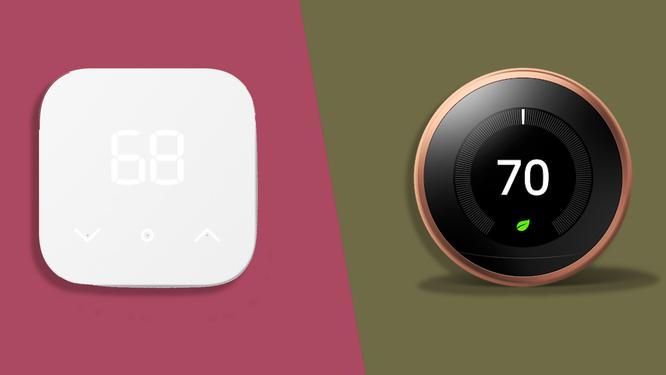Smart Thermostats have been around for more than a decade now, and offer the ability to control your heating and cooling systems from your smartphone, even if you’re not at home. Amazon may be new to the smart thermostat market, but its first attempt has created quite a stir – not least because it is priced significantly lower than most of its rivals - including Ecobee.
The retail giant has taken a simpler approach to the design of its first smart thermostat but hasn’t skimped on the features that really matter, like artificial intelligence and the ability to lower your home energy bills.
Price
As we alluded to earlier, the Amazon Smart Thermostat massively undercuts most of its rivals. Priced at just $60 (or $70 if you require a C-wire), the Amazon represents excellent value for money. While the EcoBee SmartThermostat featured here is $250 – the same as the Nest Learning Thermostat, but four times that of the Amazon.Although Ecobee does offer cheaper models, with the Ecobee 3 Lite- its entry-level device costing $180.
Price is particularly important with smart thermostats, as these are devices whose primary purpose is to save you money. Even if the device promises to lower your energy bills using artificial intelligence, the Amazon option already has a $190 head start. The Ecobee will have to save you $250 before even starting to pay for itself. For those looking to build out a smart home system, that $190 saving with the Amazon thermostat could go towards a lot of smart lights, plugs and other Alexa-controlled devices.
All that said, the Ecobee at least comes with a SmartSensor in the box, which can be used to help tell the thermostat about the temperature in a key room of your home, such as the lounge or bedroom. Ecobee sells these sensors in packs of two for $100..
Design
Both are a similar size and shape, and should look at home wherever they are installed. The Amazon measures 3.5in by 3.5in and is 0.84in thick, while the Ecobee is 4.29in square and 1in thick. Both come with trim plates designed to cover any marks, holes or unpainted parts of the wall left by your old thermostat.

The Ecobee is more rounded than the Amazon, and mostly black instead of white, but there really isn’t much to split their design. Neither can be bought in different colors, but their simple and inoffensive aesthetic means they will surely fit in well in any home.
Where the Amazon device has a simple LED display for showing little more than the temperature and heating or cooling mode, the Ecobee has a color LCD touchscreen. This can be used to set the temperature, but also dig into the thermostat’s settings menu, adjust the schedule and view the local weather forecast. A quad-core processor ensures the system responds quickly to tapping and swiping.
Unlike Nest thermostats and their rotating dials, both the Amazon and Ecobee are controlled by tapping or swiping. The Amazon thermostat has three touch-sensitive icons for raising or lowering the temperature, and a central icon for changing mode. The temperature of the Ecobee is changed by swiping up or down on the touchscreen.
The Ecobee has an integrated microphone and speaker, so you can control it by talking to Siri or Alexa. The Amazon thermostat misses out on this, and is instead controlled by speaking to other Alexa devices, like Echo smart speakers elsewhere in the home.
Features
Being smart thermostats, both of these devices connect to the internet via your Wi-Fi network, then can be controlled from home or remotely using a smartphone app. They also tap into smart home systems, but in Amazon’s case this is limited to the company’s own Alexa platform, which can be used to adjust the temperature with voice commands.
The Ecobee is much more flexible, with support for Alexa, plus Google Assistant, Apple HomeKit, Samsung SmartThings and IFTTT. This makes it the better option for smart homes that use systems other than Alexa. Also, because it has a microphone and speaker, you can speak directly to the Ecobee, which can run either Alexa or Siri natively. That’s right, we now live in a world where you can ask your thermostat to set a reminder, read the weather forecast, or tell a joke.
Energy-saving is a key feature of both thermostats. The Ecobee uses the company’s Eco+ system, which adjusts the temperature depending on humidity, your preferred schedule, and the price of peak/off-peak electricity. The system automatically adjusts when it senses you’ve left, then changes again when you return home.
The Amazon thermostat works in a similar way, using the Alexa Hunches system to work out what’s going on in your home. For example, if your smartphone location is away from home and no one has interacted with any of your Alexa devices for a while, the heating will be lowered.
Amazon says its thermostat uses Echo devices to further understand conditions in the home, but doesn’t say exactly how this works. With Ecobee, its thermostat can be connected to a number of sensors, one of which is included with the SmartThermostat.
These tell the thermostat the ambient temperature, giving the system a better idea of which rooms require warming or cooling. The user can then have the thermostat work to bring a certain room, like the bedroom, to a preferred temperature, regardless of how warm anywhere else is in the home.
Ecobee also sells window and door sensors, which instruct the thermostat to switch off the air conditioning if one is left open for more than five minutes.
Verdict
Deciding between these two smart thermostats comes down to two key factors – price and smart home integration. The Amazon model is considerably cheaper, so if you are happy to live within the Alexa walled garden, it is clearly the one you should go for. But if you prefer the greater integration of the Ecobee (or don’t have any Alexa devices) then that’ll be the one for you.









